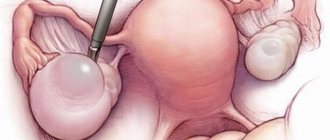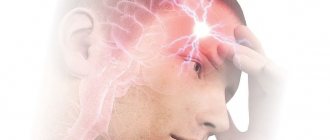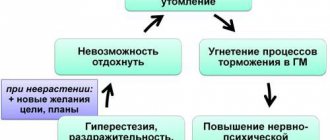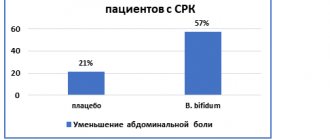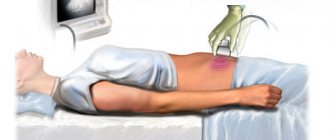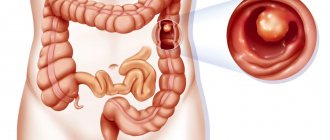Asthenia
or
asthenic syndrome
(Greek asthenia - impotence, weakness) is a pathological condition that manifests itself as increased fatigue, weakness, emotional instability, sleep disturbances, and autonomic disorders.
Asthenic syndrome is common in all social strata of society, among all age groups. But the most vulnerable group is women, and the peak age of incidence is between 30 and 50 years.
In the “Your Health” clinic, to accurately diagnose asthenia and determine the level of maladaptation of the body, a modern VNS technique is used - spectrum, based on spectral analysis of the heart rhythm.
What is asthenic syndrome, asthenia?
Asthenic syndrome is a syndrome characterized by a state of mental irritable weakness, rapid depletion of nervous processes, unstable mood, impatience, decreased performance for prolonged physical activity and mental stress, intolerance to bright light, loud sound, strong smell, emotional lability, and sleep disturbances. The term " asthenic syndrome " comes from the Greek word "astheneia", which means "weakness, impotence". Asthenic syndrome has synonyms - chronic fatigue syndrome (CFS, CFS), asthenia , asthenic reaction , asthenic condition , asthenia of the nervous system .
Asthenia scale
The asthenic state scale was developed by L.D. Maykova, adapted by T.G. Chertovaya on the basis of clinical and psychological observations and the well-known MMPI questionnaire (Minnesota Multidimensional Personality Inventory).
The scale consists of 30 items of statements reflecting the characteristics of asthenic syndrome. The study is carried out individually in a separate, well-lit room, isolated from extraneous sounds.
Instructions for the test: Read each sentence carefully and evaluate it in relation to your current state.
Points for each answer are awarded according to the following scheme:
- No, not true – 1;
- Perhaps so – 2;
- True – 3;
- Absolutely right - 4.
Test material:
- I work under a lot of pressure;
- I find it difficult to concentrate on anything;
- My sex life does not satisfy me;
- The waiting makes me nervous;
- I am experiencing muscle weakness;
- I don't feel like going to the cinema or theater;
- I'm forgetful;
- I feel tired;
- My eyes get tired when reading for a long time;
- My hands are shaking;
- I have poor appetite;
- It is difficult for me to be at a party or in a noisy company;
- I don't understand what I read so well anymore;
- My hands and feet are cold;
- I am easily offended;
- I have a headache;
- I wake up in the morning tired, not rested;
- I get dizzy;
- I have muscle twitching;
- I have a buzzing in my ears;
- I am worried about sexual issues;
- I feel heaviness in my head;
- I experience general weakness;
- I experience pain in the crown of my head;
- Life for me is about tension;
- My head seems to be tied together with a hoop;
- I wake up easily from noise;
- People bore me;
- When I worry, I break out in sweat;
- Restless thoughts keep me awake.
The possible number of points ranges from: 30 -120
The test results can be interpreted as follows:
- From 30 to 50 points – “absence of asthenia”;
- From 51 to 75 points – “weak asthenia”;
- From 76 to 100 points – “moderate asthenia”;
- From 101 to 120 points – “severe asthenia”
Asthenic syndrome in children: symptoms
What is the clinic for asthenia in children? Asthenic syndrome in children has characteristic symptoms : tearfulness, moodiness, increased drowsiness, fatigue, fatigue, excitability, overexcitability, poor sleep, motor disinhibition, dizziness. At school, gymnasium, and lyceum, children remain productive only in the first lessons and in the first half of the school hour. Children with asthenia or asthenic syndrome have poor attention, they are often distracted in class, attention is depleted, immunity decreases, and childhood diseases occur. Children often make mistakes, miss letters, underwrite letters, swap letters, double letters, underwrite words, forget to put commas or periods, and make incorrect indentations. With asthenia, with asthenic syndrome, autonomic reactions and autonomic disorders are often observed: acrocyanosis, hyperhidrosis (excessive sweating), poor appetite, discomfort, pain, unpleasant sensations in the heart (in the heart area).
Diagnosis of the disease
To diagnose the disease, the patient turns to a therapist, who can refer for an additional appointment with a neurologist, psychotherapist, psychiatrist, chiropractor or psychologist. If asthenia is associated with other pathologies, consultation with a cardiologist, gastroenterologist, traumatologist, gynecologist, infectious disease specialist or urologist may be required.
At the first appointment, an examination is carried out and the medical history is studied. The patient is asked several questions:
- what diseases have been observed recently;
- whether there were severe stresses;
- Has work become more difficult?
- whether your general health has worsened;
- Are there any problems with sleep?
- Do you have problems with mood, etc.
Asthenic syndrome in adults: symptoms, signs, manifestations of asthenia
What is the clinic for asthenic syndrome in adults, men and women? Asthenic syndrome in adults (men, women), in adolescents (boys, girls) has typical symptoms : irritability, restlessness, sleep disturbance, intolerance to loud sound, fatigue, mood swings, bad mood (low, depressed mood), poor mental tolerance and physical activity, fatigue, decreased self-control, intolerance to bright light, impatience, inappropriate behavior, intolerance to strong odors, poor willpower, irritability, excitability, melancholy, apathy. The person feels tired, but often continues to do something. Lethargy can occur without exercise and does not go away even after rest. Sometimes in old age there is a decrease in memory, headache, fatigue from life, mentism (involuntary flow of thoughts), tearfulness, increased tearfulness, hyperesthesia, tearfulness (unreasonable crying for any minor reason), whims (moody). They are also characterized by “harassing”, “harassing” relatives, dissatisfaction with work, life, financial condition, and people around them.
How is the cause of asthenia diagnosed?
There are many treatment options for asthenia. But the first thing necessary for successful treatment is to determine the underlying cause. First, your doctor will order a urine test and/or blood test to look for signs of infection and possible medical conditions that may be causing weakness. If you have pain, your doctor may prescribe:
- X-ray
- MRI scan
- Computed tomography
- Ultrasound.
If a heart attack or stroke is suspected, you will be referred for a brain scan and electrocardiogram.
Asthenic syndrome, causes of asthenia
Asthenia and asthenic syndrome have certain causes of development. What are the main reasons for the development of asthenia and asthenic syndrome?
- Adynamia, physical inactivity.
- Great physical or mental stress, overload.
- Exposure to an electromagnetic field (EMF) is electromagnetic radiation.
- Excitement, stress, worry, conflicts.
- Hypertension, hypertension, hypertension, high, high blood pressure.
- Depression, depressive state.
- Working on a computer for a long time, watching TV, talking on a cell phone, using devices such as microwave ovens (microwave ovens), tablets, tablets, smartphones.
- Alcohol abuse, alcoholism.
- Intoxication.
- Infectious diseases, STIs.
- Coronary heart disease (CHD), angina pectoris, myocardial infarction.
- Constitutional characteristics of a person.
- Weather sensitivity, intolerance to changes in atmospheric pressure, intolerance to magnetic drills, increased solar activity (solar flares).
- Hereditary predisposition.
- Neurosis, neuroses.
- Improper organization of work, overtime at work, irregular work schedule.
- Nervous diseases, diseases of the nervous system.
- Organic diseases of the brain, central nervous system, central nervous system.
- Obesity.
- Human psychotype (psychological type of the nervous system).
- Overload of the nervous system in educational institutions (institute, university, academy, school, gymnasium, lyceum, technical school, college, kindergarten, courses).
- Poor emotional atmosphere at work.
- Poor nutrition, anorexia.
- Post-traumatic arachnoiditis.
- Mental illnesses.
- Psychosis, psychoses, psychopathy.
- Somatic diseases.
- Chronic diseases.
- Traumatic brain injury, traumatic brain injury, concussion, brain contusion, brain compression.
- Schizophrenia, initial stage.
Causes of asthenia
Weakness is a feeling of physical or nervous fatigue. A person experiencing weakness cannot move one or another part of his body correctly. He may also experience tremors.
Sometimes people experience weakness only in a specific part of their body, such as their arms or legs. In other cases, people may experience full-body weakness, which is often a symptom of a bacterial or viral infection such as hepatitis or influenza. Asthenia may be temporary, but in some cases it is chronic or continuous.
Asthenia, asthenic syndrome, types of asthenia in men and women
Neurologist, neuropathologist, reflexologist, reflexologist distinguish types of asthenia , types of asthenic syndrome : morning (morning), daytime (day), evening (evening), nocturnal (at night) asthenia (neurotics), neurocirculatory asthenia, functional or organic asthenia, mental asthenia ( psychological), psychogenic and physiogenic, cerebral asthenia, infectious (post-infectious), post-viral (post-viral, post-viral asthenia syndrome), alcoholic (post-alcoholic), sexual (post-sexual), tonic, hypersthenic, hyposthenic, somatogenic (somatic), neurocirculatory, agastric, skin , traumatic (post-traumatic), neurasthenia . Reflexotherapists, neurologists, neuropathologists distinguish various variants of asthenic syndrome: astheno-vegetative syndrome, astheno-subdepressive syndrome, astheno-hypochondriacal syndrome.
Astheno-vegetative syndrome is characterized by both manifestations of asthenia and severe autonomic disorders.
Astheno-subdepressive syndrome is a non-psychotic pathological condition characterized by mild melancholy with a feeling of loss of vitality and activity. Physical and mental fatigue, weakness, exhaustion, mental and emotional hyperesthesia, emotional lability, absent-mindedness and distractibility of attention are observed.
Astheno-hypochondriacal syndrome is characterized by a combination of asthenia with exaggerated concern for one’s health.
VSD (vegetative vascular, vegetative vascular dystonia) of mixed, hypotonic, hypertonic type.
What to do if asthenia occurs?
First of all, it is necessary to exclude all external stimuli. In most cases, this is the most effective method of eliminating asthenic manifestations
.
If asthenia is a manifestation of a pathological process in the body, then additional consultation with a doctor will be required to detect abnormalities in the body, conduct diagnostics, obtain reliable data on the state of health and prescribe the necessary treatment.
asthenic syndrome signs
Prevention of asthenia
Sarklinik has developed an effective program “ Prevention of asthenia ”, which allows you to avoid future exhaustion of the nervous system. A healthy nervous system is a reality today. The peculiarity of the disease is that the symptoms slowly, gradually, but clearly increase, and the condition worsens sharply. Do not expect dangerous complications of asthenia, asthenic syndrome; contact Sarclinic for timely treatment.
Sign up for a consultation. They have contraindications. Specialist consultation is required.
Photo: (©) Bds | Dreamstime.com \ Dreamstock.ru The people depicted in the photo are models, do not suffer from the diseases described and/or all similarities are excluded.
Related posts:
Occipital neuralgia: symptoms, treatment in Saratov
Phobia, fear, how to get rid of fear, how to overcome, treat and overcome fear, treatment in Saratov
Insomnia, treatment of insomnia in Saratov, what to do for insomnia
Nervous exhaustion symptoms signs treatment, exhaustion of the nervous system
Transient ischemic attack: symptoms, treatment of the brain
Comments ()
Symptoms of asthenia
- Has fatigue become your usual state?
- Are the days divided only into those when you are simply tired and “deadly” tired?
- The sight of frolicking children and youth only evokes in you a silent question: “Where do they get so much energy?”
- Isn’t this the first day you’ve had this impression of life?
- Is your sleep disrupted, but calculating sheep and rams doesn’t help?
- Bags under the eyes, dull eyes, a forced smile, a total reluctance to do anything?
Doesn't remind you of anyone? Every second patient today consults a doctor with such complaints.
Treatment of asthenia
Treatment of asthenia can be carried out in different ways, but all of them are aimed at relieving the symptoms of the disease.
Having diagnosed asthenia, doctors usually prescribe the patient drug therapy, consisting of antidepressants. This is due to the fact that in most cases, people with symptoms of asthenia often also have signs of depression. Therefore, until depression is eliminated, it is simply impossible to talk about successful and effective treatment of asthenia. In some cases, taking small doses of antidepressants helps improve sleep and relieve pain. Sometimes doctors prescribe sleeping pills for these purposes.
For the most effective and efficient treatment of asthenia, a method called the “dual approach” is used. It combines a course of psychological counseling with a special program of therapeutic and physical exercises. The development of an exercise program is carried out by a physiotherapist, whose tasks include selecting individual physical activity for each patient individually. Psychological consultation is aimed at identifying external and internal factors that have an adverse effect on the patient, and teaching the person how to control them.
Asthenovegetative syndrome: symptoms
The clinical picture of asthenovegetative syndrome is characterized by gradual (stepwise) development. In approximately 5-7% of cases, clear signs of the disease may be observed.
The following symptoms are characteristic of asthenovegetative syndrome:
- decreased performance;
- absent-mindedness;
- memory losses;
- genital dysfunction;
- difficulty in formulating thoughts;
- tension, anxiety, irritability;
- fast fatiguability.
Patients lose interest in their favorite activities. The patient gradually begins to forget important and necessary information, often used in work. School-age children's performance declines and apathy appears. It becomes more and more difficult for people with similar functional disorders of the autonomic system to formulate thoughts. Attempts to concentrate on a specific object are unsuccessful; they only bring greater fatigue and dissatisfaction with oneself.
In combination with asthenovegetative syndrome, a hypochondriacal disorder appears, manifested by constant worry about one’s health.
The following symptoms of the disease are typical for patients of any age and gender:
- chronic weakness;
- tachycardia;
- dyspnea;
- frequent fainting;
- presence of cold extremities;
- the appearance of pressing headaches;
- functional digestive disorders;
- profuse sweating.
Later, tinnitus occurs, urination problems occur, appetite decreases, and then disappears. Regarding dysfunctions of the genital organs, such disorders manifest themselves to varying degrees. Some patients may experience a complete absence of sexual arousal due to erectile dysfunction, or, conversely, constant sexual arousal. At the very last stages of the development of the disease, sleep disorders appear - insomnia and night headaches appear that are not relieved by painkillers.
Back Next
Asthenic syndrome, asthenia (from the Greek a - absence, sthenos - strength) is a pathological condition characterized by quickly onset fatigue after activity of normal intensity.
Develops with:
1. All moderate and severe diseases and infections . It is the most common syndrome in medicine (!), an indispensable component of many diseases. For example, with influenza or ARVI, increased fatigue is present: a) in the prodromal period (weakness, weakness, fatigue are the main components of this period); b) at the height of fever (weakness up to maximum severity - “asthenic prostration”); c) during the period of convalescence (increased fatigue is again the leading characteristic of the condition).
2. Chronic fatigue (physical and/or mental). Overwork may be due to objective reasons (for example, illness of a child, difficult material and living conditions, including among migrants and internally displaced persons, etc.), but in the modern world it more often has a “psychogenic” nature (previously such cases were considered as one of the types of neuroses is neurasthenia). In these cases, overexertion is caused by the peculiarities of a person’s subjective assessment of his situation, when he makes excessive demands on himself, plans more things for himself than he can actually accomplish, wants more for himself than he can achieve, thereby driving himself into a state of chronic overwork ( Currently, this type of formation of overwork is attributed not to mental disorders, but to psychological, non-medical problems).
Asthenia should be distinguished from fatigue as a physiological (normal) state:
| Fatigue | Asthenia |
| Physiological (normal) state | Pathological (painful) condition |
| Occurs after significant stress: physical work of high or unusual intensity (for example, loading heavy objects associated with moving, unusual sports activities, tourism, etc.); significant mental stress (for example, preparing for an exam, which does not take the student the entire semester, but only the last few days before the exam, etc.) | Chronic condition. Fatigue worsens after the daily activity that a person performs day after day |
| Characterized by a temporary decrease in body activity after stress | Characterized by a steady decrease in body activity as a result of chronic overexertion and/or exhaustion due to somatic illness |
| Completely disappears after normal rest (night sleep, weekend rest, etc.) | Does not go away after normal rest |
| Does not require special treatment | Often requires special treatment, since by its nature it is a chronic and difficult to reversible condition |
Clinical manifestations:
1. Increased fatigue
Physical - weakness (including in muscles, limbs), fatigue, desire to rest, interrupt work, reduced productivity.
Mental – primarily difficulties with maintaining attention. Because of this, complaints about deterioration of intelligence and memory, errors due to inattention, unfinished tasks, ineffectively spent time (work takes much more time than required in normal conditions).
For example, a student, preparing for a test or exam, reads a chapter of a textbook, but is unable to maintain attention on the material being studied, highlight and remember the most important points, is distracted by extraneous thoughts, as a result, after reading the chapter, an impression is created (often justified) that he did not understand or remember anything. In such cases, some students, hoping for the “25th frame effect” or the consolidation of memory traces in a dream, go to bed, others (more responsible) begin to reread the material again, but since fatigue only accumulates, the effectiveness of rereading is again low.
Since one of the most “resource-intensive processes” when studying educational materials is highlighting key points from the textbook text (often very lengthy), in this textbook the authors will try to help students and do part of the work for them, putting the most important points on the slides (images) at the beginning each of the subchapters.
2. Hyperesthesia, pickiness, grumpiness, irritability, mood swings for minor reasons (emotional lability)
We can simply say that people in this state do not have enough strength to “restrain themselves” (control themselves), to keep their dissatisfaction with something or irritation to themselves.
We can observe typical situations in public transport or in queues, when a foot that has been stepped on, a small accidental push or other inconvenience causes a violent reaction of irritability, including verbal abuse or even assault. Of course, in such situations one cannot ignore both personal characteristics and the factor of a person’s general culture, his upbringing, as well as the cultural norms of society as a whole. Unfortunately, in Russia such reactions in public places are quite common, and this is an additional factor inciting our compatriots not to restrain themselves. In many European countries, in most cases, the person whose foot you stepped on will be the first to apologize to you for being in the way. Of course, this difference cannot be attributed only to the difference in the cultural level of our societies; it can also be justified by the greater general asthenia of our entire society due to worse living conditions. In addition, we must not forget about the chain reaction effect, when we “infect” each other with similar negative emotions in everyday situations.
Quite often, emotional reactions of irritability are observed in medical institutions, not only in patients whose asthenia can be explained by a somatic disease, but also, unfortunately, in medical personnel who have asthenia, which is one of the pathogenetic links in the development of emotional burnout , probably during In many ways, it can be caused by overwork due to improper organization of work (excessive loads in order to earn an acceptable salary, part-time work, performing tasks unusual for the position, night shifts, etc.). The task of the managers of medical institutions of competent labor organization is to try to prevent the development of asthenia in their employees.
3. Sleep disorders. Sleep disorders with asthenia are present not only during the night, but essentially throughout the entire day.
- Evening: difficulty falling asleep. The phenomena of hyperesthesia are characteristic, when attention is attracted by the slightest inconvenience, noise from neighbors, the pounding of one’s own heart, an uncomfortable bed, etc. Sometimes an abundance of thoughts prevents one from falling asleep (they are usually emotionally neutral in content; anxious, exciting thoughts in the same way prevent one from falling asleep during anxious states).
- Night: shallow, restless sleep, frequent awakenings, nightmares.
- Morning: difficulty waking up, lack of feeling of rest after sleep. Often, it is at the moment the alarm clock rings that drowsiness sets in (finally!); after getting out of bed, a feeling of tiredness and tiredness is already expressed (in the morning, even before starting any activity!).
- Day: daytime drowsiness, difficulty concentrating, additional efforts are required to overcome drowsiness and concentrate on work (this wastes additional energy and closes the vicious circle of asthenia - see below). In the second half of the day he becomes more active, collected, efficient, but because of this he cannot fall asleep or delays going to bed later than the required time.
Not all people with asthenia complain of difficulty falling asleep; often they do not suffer because they lie down and cannot fall asleep, but because of their condition (lack of inhibition processes; see below the “vicious circle” of asthenia) they postpone sleep sleeping later than the required time (distracted by minor things that could be done at another time, for example, watching TV, communicating on social networks, etc.). A sign in this case will be a general reduction in sleep duration (for example, a student regularly goes to bed at 1–2 a.m. when he has to get up at 7 a.m.).
4. Various autonomic disorders:
- Headache. One of the most common complaints. There are two main types of headaches: migraine (unilateral, usually affecting the temporal region, orbit, forehead; pulsating, intense, complicating functioning, accompanied by severe hyperesthesia. For more details, see the neurology cycle) and tension headache (pressing, squeezing like a “helmet” or “tight hoop”, bilateral, usually extends from the back of the head, associated with tension in the muscles of the scalp and neck). It is the second type of pain that is one of the most common autonomic disorders with fatigue and asthenia, while with migraine the symptoms of asthenia are also quite pronounced, but they appear secondary to the migraine itself.
- Hyperhidrosis, sweating, hot flashes or, conversely, chilliness, including in the extremities.
- Heartbeats. Due to a violation of the tone of the autonomic nervous system, heart rhythm disturbances, including an increase in the number of extrasystoles, are quite real with asthenia (complaints about them cannot be reduced to autonomic hyperesthesia). It is necessary to take into account that substances with a stimulating effect (coffee, energy drinks, etc.), which many people use to overcome lack of attention and daytime sleepiness due to asthenia, may therefore pose an additional health hazard by potentiating existing rhythm disturbances.
- Dizziness.
- Dyspeptic disorders.
When vegetative disorders occur without significant somatic causes in our country, internists often diagnose “vegetative-vascular dystonia”, while the psychological causes of these conditions are often completely ignored (and in addition to asthenia, similar symptoms can occur with masked depression, panic attacks and other mental disorders ), and therefore patients do not receive adequate therapy.
Processes of excitation and inhibition in the nervous system and the “vicious circle” of asthenia
Outstanding Russian physiologists of the late XIX - early XX centuries. I.M. Sechenov and I.P. Pavlov studied the processes of inhibition and excitation in the nervous system; later, I.P. Pavlov’s teaching regarding the pathogenesis of asthenia was developed by A.G. Ivanov-Smolensky.
Inhibition processes are “higher” in relation to excitation processes, they limit excessive excitation, “keep it within limits”, while in ontogenesis they themselves are formed later than excitation processes and are more sensitive to external unfavorable factors. For example, we know that it is arbitrarily difficult for a small child to sit quietly in one place for a long time, he wants to run and scream, but gradually, as his nervous system matures, he begins to control his behavior better and better, and already at school most children can calmly withstand 40 - minute lesson. Another example: it is believed that a “well-mannered” person differs from an “ill-mannered” person by greater restraint, calmness and self-control, i.e. his inhibition processes are better developed.
When any external harmful effects act on the brain, the inhibition processes are first disrupted, excitation “comes free”, and only with a further increase in the influence of pathogenic factors does the excitation processes become suppressed. This, as we will see in other sections, is characteristic not only of asthenia, but also, for example, of alcoholic intoxication: alcohol is a sedative in itself, large doses can cause sleep or even coma, but in small doses the effects of alcohol, on the contrary, appear speech and motor stimulation.
In the case of asthenia, a change in the tone of the processes of excitation and inhibition forms a “pathological vicious circle”: chronic fatigue leads to exhaustion of the inhibition processes, the released excitation does not allow a person to rest, strength is depleted even more, overwork intensifies, and the vicious circle closes.
Manifestations of such a circle at the level of the circadian rhythm: people in a state of asthenia at the end of the working day become more active and active than in the morning (inhibition processes are exhausted). In the evening, they take on new things, do one thing or another, because of this they either go to bed later than the required time (since they “were busy”), or cannot fall asleep. At night, shallow restless sleep does not allow rest (again due to the exhaustion of inhibition processes), but in the morning drowsiness occurs (“protective” inhibition according to I.P. Pavlov). During the day, drowsiness persists and additional efforts are required to overcome it. At the end of the working day, the inhibition processes are exhausted again, and the vicious circle repeats from the beginning.
Stages or severity of asthenia:
The clinical picture of asthenic syndrome is changeable, dynamic, and is largely determined by the current balance of inhibition and excitation processes, which gives rise to a variety of clinical manifestations. From a clinical and neurophysiological point of view, there are three degrees of severity (or stages of development) of asthenia:
1. Asthenia with hypersthenia - characterized by severe hyperesthesia, increased irritability, distractibility of attention and the resulting decrease in performance and productivity. Complaints of weakness and lack of strength may be absent.
2. Stage of “irritable weakness” - hyperesthesia persists, short bursts of irritability are characteristic, which are quickly exhausted and often end in tears (“tears of impotence”). Attention and performance are more severely reduced; they begin work actively, but quickly get tired.
3. Hyposthenic asthenia (stage of “pure asthenia”) - characterized by “complete loss of strength”, adynamia, exhaustion of all mental processes.
Asthenia or depression?
Complaints of increased fatigue
, weakness and lack of strength are often present not only with asthenia, but also with
depression
.
Moreover, they are one of the diagnostic criteria for depression
. Asthenia and depression are really difficult to distinguish, so sometimes in clinical practice doctors make a preliminary diagnosis - “astheno-depressive syndrome.” However, the etiology and pathogenesis of these conditions are different and in order to prescribe more effective treatment, one should strive to differentiate them. With depression, complaints of increased fatigue and lack of strength arise as a subjective assessment by the patient of the psychomotor inhibition that occurs (this is a component of the depressive triad). With asthenia, such complaints are the result of exhaustion as a result of chronic overexertion and/or exhaustion due to somatic illness.
In this regard, modern diagnostic recommendations postulate that when identifying asthenia, it is necessary to exclude somatic causes, depression, anxiety disorders ( anxiety
causes general stress in a person, leading over time to chronic fatigue) and other mental disorders.
Asthenia in somatic diseases
As mentioned above, asthenia can occur in almost all somatic diseases.
Separately, sometimes previously the so-called cerebrasthenia was identified - asthenia that occurs in organic diseases of the brain, including residual organic pathology. It is one of the clinical variants of psychoorganic syndrome. In addition to the clinical picture of asthenic syndrome, in these cases neurological symptoms characteristic of the underlying disease and manifestations of psychoorganic syndrome are observed.
Asthenia within neurasthenia
Previously, the so-called asthenic neurosis (neurasthenia). It was believed that symptoms of neurasthenia arise due to the fact that, in conditions of weakened inhibition processes, a person is not able to correctly assess his capabilities and plans for himself more things than he can actually do (intrapersonal conflict between desires and available opportunities “I want, but I can not"). In recent decades, the diagnosis of neurasthenia has lost its former popularity in medicine (and was even excluded from the International Classification of Diseases, 11th revision in 2022), because our century can well be called the century of neurasthenia - the “consumer society” imposes more and more new desires with advertising, contributes to the formation of inflated demands on oneself. Those. This is a psychological problem rather than a medical one.
Popular concepts with the help of which they try to explain cases of asthenic conditions due to one or another biological reasons are:
· “Chronic fatigue syndrome” - the term gained popularity in the mid-1980s, when the Epstein-Barr virus or antibodies to it and other herpes viruses began to be detected in the blood of patients with asthenic complaints. Some epidemics of these conditions have been described, but the cause-and-effect relationship between viral infection and symptoms has not been fully proven.
· Fibromyalgia - for this condition, chronic diffuse symmetrical musculoskeletal pain (neuropathic pain/senestopathies or increased pain sensitivity, i.e. hyperesthesia), increased fatigue (including in the first half of the day), sleep disturbances, emotional and autonomic disorders. Inflammatory, rheumatic, endocrine and other causes of this condition have been suggested, but they have not been proven.
Both of these diagnoses are in many aspects controversial nosological entities; they are not recognized by all specialists; their exact etiopathogenetic mechanisms have not been determined; in most cases, in addition to the biological aspects, a significant role is also played by the psychological characteristics of the patients.
The course of asthenic syndrome and approaches to its treatment
If asthenia is caused by any somatic condition (somatogenic asthenia), then the course of the asthenic syndrome will be completely determined by the dynamics of the underlying disease; if the somatic condition worsens, the asthenia will deepen; if the asthenia improves, the manifestations of asthenia will decrease. The basis of therapy in these cases is treatment of the underlying disease.
If asthenia is caused by overwork, which has objective causes, then to improve the condition it is necessary to exclude the effects of unfavorable factors and to have adequate rest of sufficient duration, preferably with a change of environment, sanatorium treatment, physiotherapy, massage, etc.
If asthenia develops within the framework of asthenic neurosis (neurasthenia), then usually even a long rest does not provide tangible benefits, since, having returned to a familiar environment, the persisting intrapersonal conflict (inflated demands on oneself) again forces the person to begin his previous lifestyle with loads exceeding its capabilities (typical situations are when, already a few days after a vacation or vacation, such a person, distracted by unimportant matters, begins to go to bed much later than the required time, does not get enough sleep, and very soon all the symptoms of asthenic syndrome return to their previous level). In these cases, psychotherapy will be useful (including drawing up a hierarchy of life priorities, learning to separate important matters from unimportant ones, etc.), training in “time management,” training in “increasing personal effectiveness,” etc.
In all cases of asthenia, sedatives and sedatives can be used symptomatically (in order to break the “vicious circle” of asthenia). In the mildest cases - herbal remedies (valerian, motherwort, peony, etc.), in more severe and chronic conditions - antidepressants. Tranquilizers and drugs containing barbiturates are not indicated due to their unfavorable side effect profile. Substances with a stimulating effect (including coffee, “energy” drinks) are contraindicated (!), since they only aggravate the symptoms, depleting the body’s own strength (and do not bring this strength, “energy” from the outside, as advertising claims). The use of psychotropic drugs for somatogenic asthenia is possible only taking into account the balance of risks and benefits from their use.
Back Next
To see comments you must register
Do I have asthenia?
- Signs of asthenia, is it a disease?
- Can asthenia be a normal variant?
- Is this a temporary and reversible condition?
- If there are signs of asthenia, do you need medical help?
- Is it possible to avoid the disease?
- What symptoms are included in this category?
The answers to these questions have been prepared for you by our doctors. Let's start with how this condition manifests itself.
Primary signs of asthenia
- Fatigue, weakness
- Irritability, feeling dissatisfied with others
- Decreased health
- Various sexual disorders, breakdowns, etc.
- Exhausted attention with excessive specificity
- Tearfulness, increased sentimentality.
- Sleep disorders (insomnia at night, drowsiness during the day).
- Poor tolerance to loud sounds, bright lights, strong odors.
- Headache.
- Nervousness.
- Feeling of inner trembling.
- Poor appetite.
- Excessive worry about unimportant reasons.
- Difficulty in making decisions.
- Thoughts are easily lost and it is difficult to concentrate.
- Autonomic symptoms: palpitations, sweating, shortness of breath, trembling, trembling sensation.
- Unpleasant sensations in different parts of the body that can change and “migrate”.
Course of asthenia
The course of astheno-neurotic syndrome or asthenia is often associated with possible complications that accumulate and develop due to the duration of this pathological process. Therefore, doctors strongly recommend not to delay treatment of asthenia or treatment of astheno-neurotic syndrome. An exhausted nervous system is easily susceptible to the formation of a wide variety of pathologies of the mental spectrum of diseases.
Despite the fact that the prognosis for the treatment of asthenia or treatment of astheno-neurotic syndrome in the vast majority of cases has a favorable prognosis, the duration of therapy can be quite long and depends on both the depth of the disorder and the duration of its course.
Asthenia can occur in the form of attacks, with complete recovery during periods of calm. However, more often the asthenic state is characterized by a constant (often with intensification in the evening), “as a background” and long-term course.
